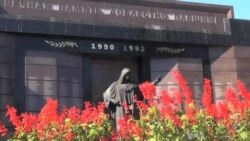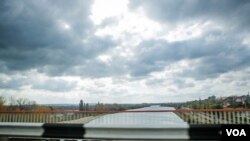TIRASPOL, TRANSDNIESTER —
Moldova and Ukraine, two former Soviet republics, seem to be starting to work toward eventual membership in the European Union. But sandwiched between them is a breakaway splinter of a region that says "no." Transdniester is the Russian-speaking secessionist region of Moldova.
From a Russian Orthodox monastery, the bells ring out across flat farmland.
In the capital, a Lenin statue greets visitors to the local Supreme Soviet. The central square is dominated by a statue of a czarist general on horseback. And a golden hammer and sickle embellishes the red flag of Transdniester.
This looks like a corner of Russia. But as the map on a local bottle of vodka shows, Transdniester is a long, skinny strip of land, sandwiched between Moldova and Ukraine.
Moldovan Prime Minister Iurie Leanca says it is a breakaway region of his country. “We are unfortunately still hosting this protracted conflict it so does not make us happy at all. It shows we still have a wound that it still bleeding,” he said.
But here in Transdniester, Russian-speaking locals say they fought a generation ago to win independence from Romanian-speaking Moldova.
Outside the new Hotel Rossia, Vladimir Yastrebchak, the region’s former ‘foreign minister,’ thanks Moscow for its support.
“Really the Russian Federation is our main strategic partner for more than 20 years, I mean for almost the whole period of Transdniester’s sovereign existence,” he said.
Russian Deputy Prime Minister Dmitry Rogozin visited Moldova last month. He warned that Russian troops will guarantee Transdniester’s autonomy.
He warned that Moldova has to take Transdniester into account when making decisions that will effect people on both sides of the Dniester River.
Moscow worries that at a meeting next month in Vilnius, Lithuania, Moldova and Ukraine will move toward membership in the European Union.
Ernest Vardanean, a journalist from Transdniester, said, “If Ukraine signs and ratifies the documents in Vilnius and after Vilnius, and if Moldova moves the same way, I guess that Transnistria will get many trouble because it will be pressed... it will be sandwiched between two pro-European countries.”
Since the Soviet collapse, as much as half of Transdniester’s working-age population has left - to work in Russia, or in the West.
Moldova’s prime minister said jobs and development eventually can reunite Moldova’s two language groups, now separated by the Dniester river.
“We need to show those living on left bank of the Dniester River. We are capable of building a political social economic system that is attractive for them as well," said Leanca. "Because just a few years ago, the roads on the right bank were as bad on the left bank, the migration was as high here as on the right bank, the health care was unattractive on either side.”
But for now, Transdniestrans seem happy to live as Russia’s lost colony in Central Europe.
From a Russian Orthodox monastery, the bells ring out across flat farmland.
In the capital, a Lenin statue greets visitors to the local Supreme Soviet. The central square is dominated by a statue of a czarist general on horseback. And a golden hammer and sickle embellishes the red flag of Transdniester.
This looks like a corner of Russia. But as the map on a local bottle of vodka shows, Transdniester is a long, skinny strip of land, sandwiched between Moldova and Ukraine.
Moldovan Prime Minister Iurie Leanca says it is a breakaway region of his country. “We are unfortunately still hosting this protracted conflict it so does not make us happy at all. It shows we still have a wound that it still bleeding,” he said.
But here in Transdniester, Russian-speaking locals say they fought a generation ago to win independence from Romanian-speaking Moldova.
Outside the new Hotel Rossia, Vladimir Yastrebchak, the region’s former ‘foreign minister,’ thanks Moscow for its support.
“Really the Russian Federation is our main strategic partner for more than 20 years, I mean for almost the whole period of Transdniester’s sovereign existence,” he said.
Russian Deputy Prime Minister Dmitry Rogozin visited Moldova last month. He warned that Russian troops will guarantee Transdniester’s autonomy.
He warned that Moldova has to take Transdniester into account when making decisions that will effect people on both sides of the Dniester River.
Moscow worries that at a meeting next month in Vilnius, Lithuania, Moldova and Ukraine will move toward membership in the European Union.
Ernest Vardanean, a journalist from Transdniester, said, “If Ukraine signs and ratifies the documents in Vilnius and after Vilnius, and if Moldova moves the same way, I guess that Transnistria will get many trouble because it will be pressed... it will be sandwiched between two pro-European countries.”
Since the Soviet collapse, as much as half of Transdniester’s working-age population has left - to work in Russia, or in the West.
Moldova’s prime minister said jobs and development eventually can reunite Moldova’s two language groups, now separated by the Dniester river.
“We need to show those living on left bank of the Dniester River. We are capable of building a political social economic system that is attractive for them as well," said Leanca. "Because just a few years ago, the roads on the right bank were as bad on the left bank, the migration was as high here as on the right bank, the health care was unattractive on either side.”
But for now, Transdniestrans seem happy to live as Russia’s lost colony in Central Europe.







